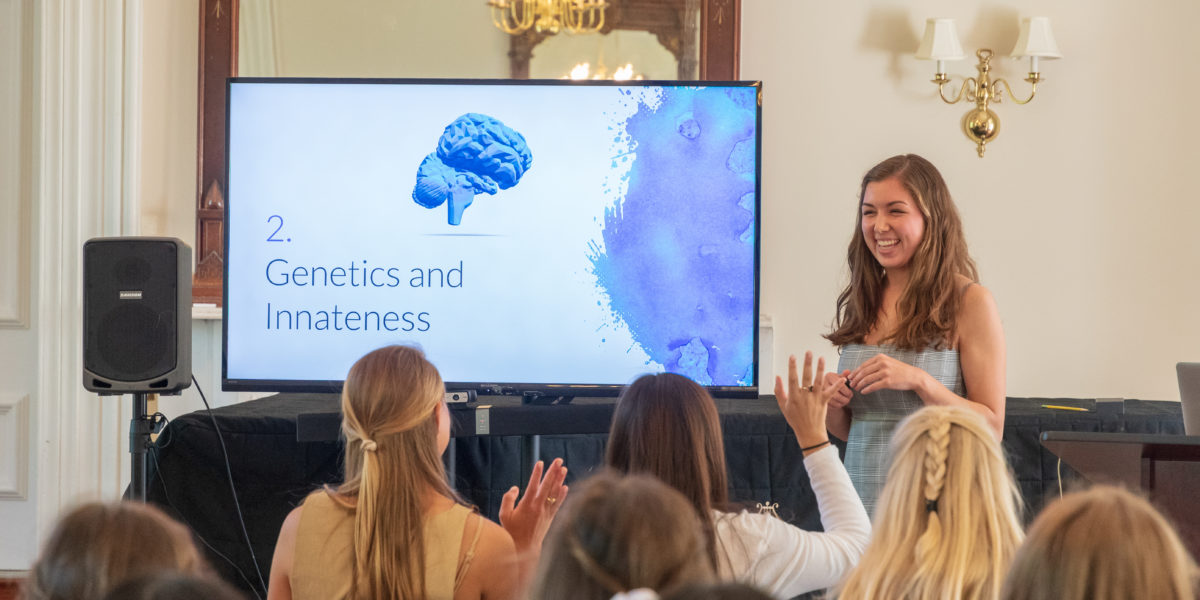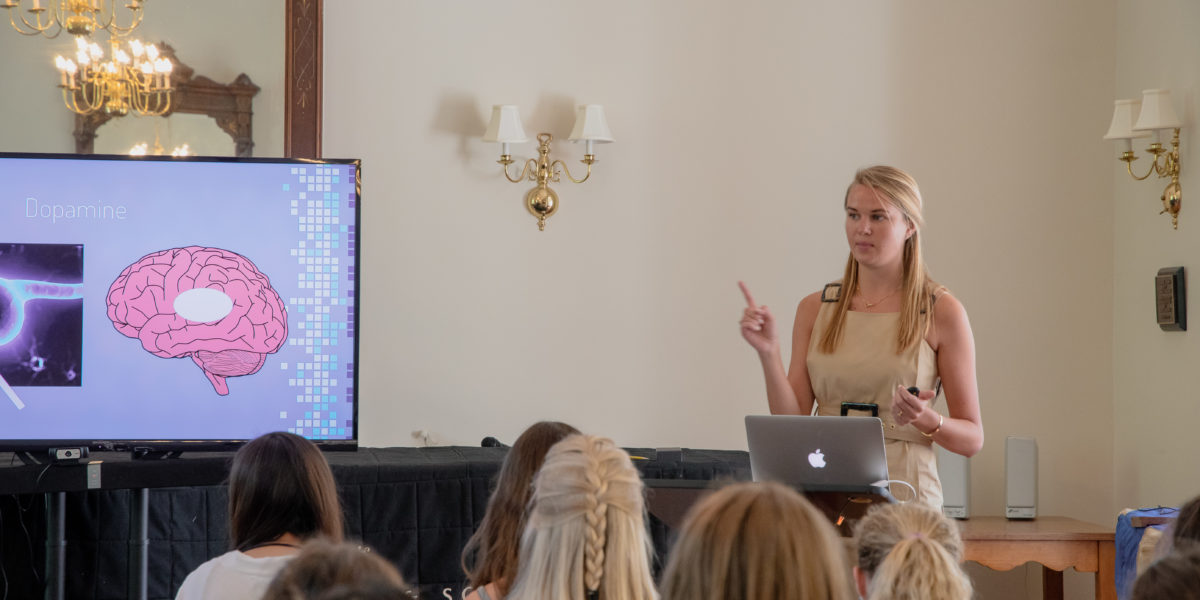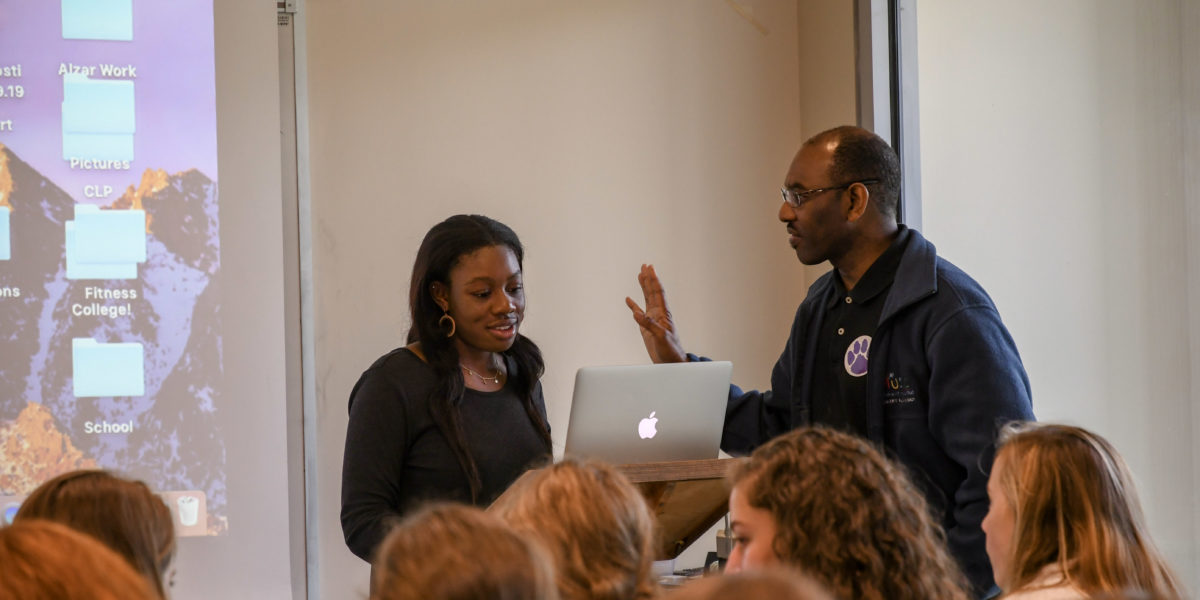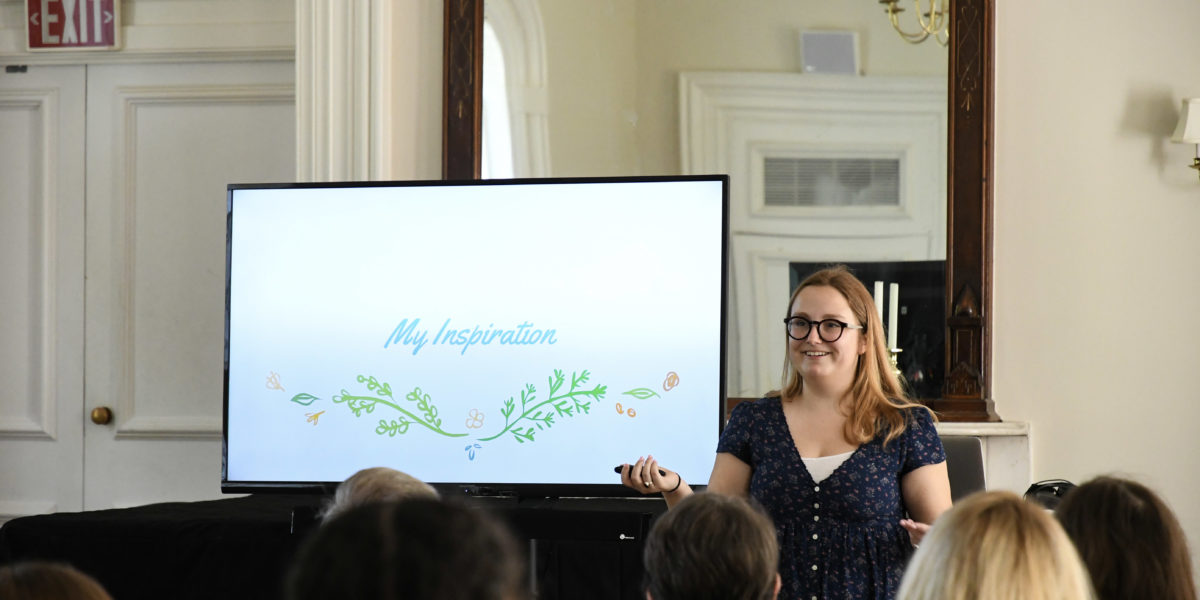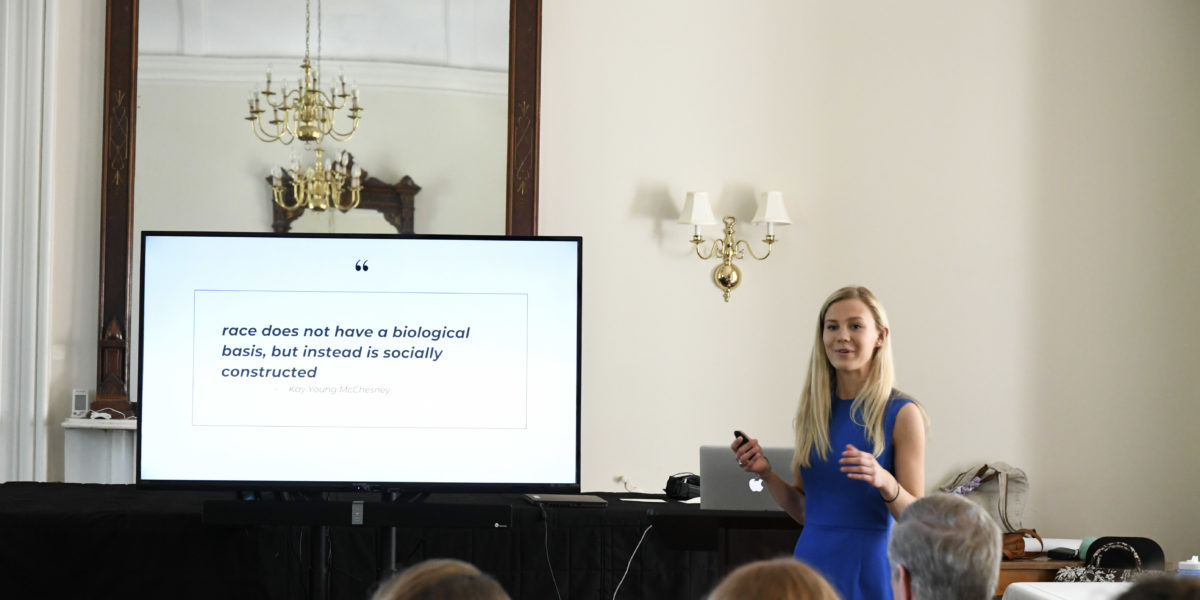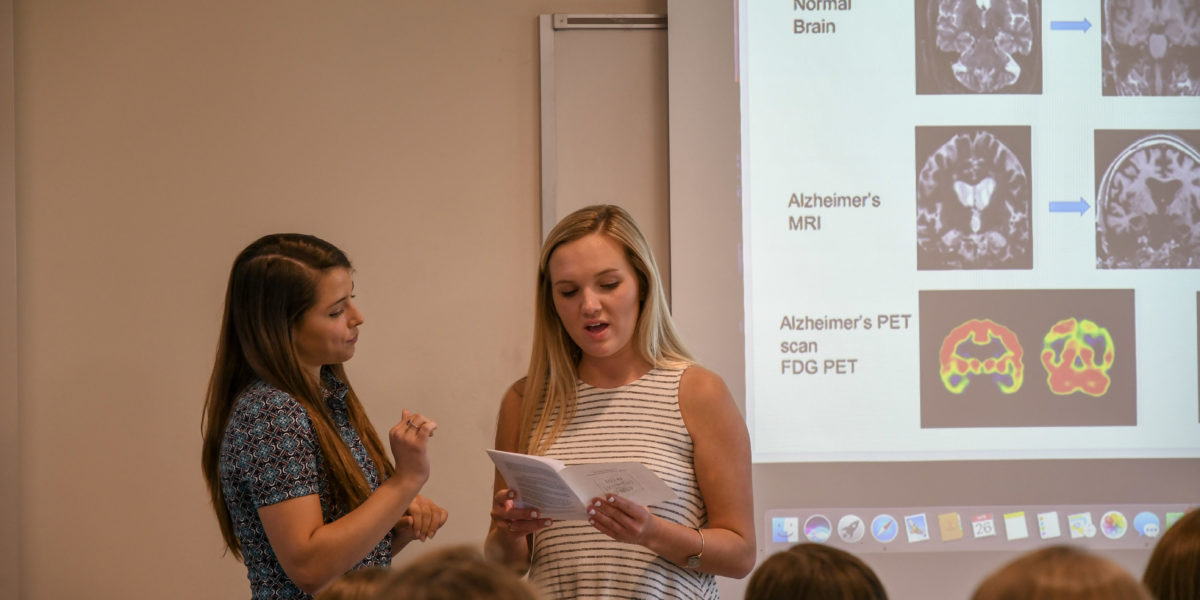Senior Projects at Ashley Hall
Senior Project at Ashley Hall is one of the school’s most distinguished programs. This student-directed, year-long class is a synthesis of intense research, critical thinking, and targeted community outreach allowing students to delve deeper into a specific topic of interest. Selected through a competitive application process the prior spring, Senior Project girls begin researching their proposed topic over the summer months. This research then fuels their work over the course of the school year as the projects evolve. During April of the following year, the girls present their Senior Project research findings to the Upper School student body along with other distinguished guests.
2019 Senior Projects
Kharynton Beggs
Technology, much like our population, is growing and expanding at an exponential rate. As we are fighting to keep up with all of the expansions, updates, and new innovations of the digital world, the focus needs to shift to look into how this is impacting younger generations. Within the last ten years, the use of technology and social media sites have become such a normal part of society that many cannot remember a time where they did not check their phones multiple times a day. This increase in social media use is a leading factor in the mental health crisis universities and colleges throughout the U.S. are facing today. This crisis can be traced back to middle school, where many mental health issues develop. With the increase in social media usage in middle school aged children, valuable life skills are being lost because some opt to have on-screen interactions instead of off-screen ones. Through my research, I intend to look at the short and long term effects of social media use on middle-school-aged-children. I will also delve into ways to help adolescents maneuver the challenges stemming from social media use, such as the loss of interpersonal and social skills, the causes of identity crises, the ability to discern the truth on the internet, and how to be a successful digital citizen.
Celia Smith
Today, Americans can share and connect with other people across a plethora of technological platforms, and health care services are not the exception. Modern telehealth encompasses the delivery of all health services across technology, a definition that is more extensive than vague. Telehealth has the power to diminish the disparities in access to health care that are felt across our nation and the world by giving its consumers equal service to doctors of all specialities from anywhere, anytime. My project was inspired by MUSC’s awardment of a multi-million dollar grant in October of 2017 and their initiative to establish the South Carolina Telehealth Alliance, which has already impacted millions of people across the state. The success of this project and others like it should be shared with the millions of people who have the potential to see positive impacts by these innovations; furthermore, it has the power to convince patients and their families that overall wellness can be improved by new relationships with physicians and the network of medical professionals that are formed through telehealth. As we become more aware of our health, we can use these platforms to help people preserve their wellness and prevent future issues of all sizes.
Ruby Baxley
Those living with physical and mental illness face myriad struggles in their internal and external lives. In addition to facing adversity, they also combat society’s misinformed perceptions and beliefs surrounding their deficits. According to the American Psychological Association, only 25% of adults with a mental illness believe others are sympathetic towards their condition. As cited by multiple sources and studies, the unfamiliarity of psychiatric issues, an individual’s physical limitations, and the mental health system as a whole all contribute to the perpetuating negative stigmas surrounding physical and mental illnesses. As a result, individuals living with a disability have been known to self-stigmatize. My project’s goal is to let the Ashley Hall and wider Charleston community know that individuals with disabilities have not, in fact, allowed these challenges to prevent them from achieving their dreams and making a positive impact on our society.
Paige Champlin
When we look back on human history, we not only study the factual evidence of what major events took place within a period, but also the artistic relics which reflect how those members of the period felt, worked, and lived at the time. Just as Shakespeare’s plays reflect the heavily structured Elizabethan Era, the eruption of the Harlem Renaissance’s visual and musical pieces reflected the “new negro movement,” and the expressionist movement reflects the emotional turmoil of the First World War, artistic expression has been a refuge and record of individuals within the LGBTQ+, or “queer-trans” community. From political visual art to the rise of musical theater, from modern dance to literature and poetry surrounding queer theory, art has been part of the lives of LGBTQ+ people since 500 BC. By looking at artists’ work within a “queer” context, we are able to more thoroughly understand these pieces within the realm of queer history, as well as the world at large. My Senior Project takes a look into queer-trans theory and the art which gives emotional texture to the community in order to better understand how the lives of queer and trans have been lived. By studying great artists such as Frida Kahlo, Sappho, Keith Haring, and many more, I seek to inform others about the importance and history of the queer-trans community, explain how art has helped liberate the community in the past, and show through outreach how it can help usher in more positive change going forward.
Isabella Hassett
Play is defined as fun, voluntary, flexible, intrinsically motivated, without extrinsic goals, and involves active engagement-commonly incorporating elements of make-believe. Using methodology ranging from Montessori to Waldorf to Reggio Emilia, early childhood educators and developmentalists have not yet been able to identify which curriculum is most conducive to healthy child development. Using current research on what types and ways play can best be incorporated into the classroom, my mission is to create the ideal, early-childhood, playful learning curriculum. If successful, it will stimulate children and allow them to meet significant milestones, while still having fun. Further, I intend to research United States’ policy and standards for preschool education systems, to ensure my curated curriculum is accepted in accordance with US standards.
Catherine Dixon
I have been enthralled with the process and implementation of foreign language acquisition since my first, albeit overdue, interaction with it in sixth grade. Since then, I have become more reflective and inquisitive than ever in understanding the actual process by which I have been able to study six languages over the past six years. Ashley Hall’s conversation-based classroom approach, combined with the bi-annual Oral Proficiency Interview and the emphasis on building confidence to speak one’s mind, even in a non-native language, prepares students for success in indescribable ways. After experiencing this firsthand, I am now fascinated with how to train teachers to produce and execute this efficient language learning environment. Teachers play the second most vital role in the classroom, and their preparedness is apparent when students emerge as bilingual, culturally aware, and confident global citizens, ready to step out of their comfort zones. I hope to produce an ideal model for foreign language acquisition on a beginner’s level; from there, I will suggest the same methods for training language educators because my research proves a training session that mirrors the foreign language classroom yields unparalleled success. If this model provides even one student the same opportunities and experiences I have been granted through this student-centered approach, I will have impacted the life of a future forward-thinking and globally aware citizen.
Amanda Goldman
Throughout history, society has been fascinated by women’s clothing. As models walk the runway and celebrities stroll the red carpet, the question inevitably asked is: “Who are you wearing?” Fashion designer Coco Chanel was one of the first to recognize the power of dressing women, and she revolutionized the industry in the 1920s by introducing trousers as an essential element of a fashionable woman’s wardrobe. The fashion pendulum has swung repeatedly throughout the decades, from binding corsets to mini-skirts, tea-length dresses to hot pants. In order to understand the rationale behind these fashion trends, it is necessary to examine the history of feminism and, in particular, how its distinct waves (defined by periods of time and social movements) influenced women’s clothing choices. Once I have this historical perspective of fashion and feminism, I will then be able to explore the connections which exist between how a woman dresses and the way she is perceived by society, as well as how she perceives herself.
Lucy Thornhill
Hermes, Chanel, Dolce and Gabbana, and Gucci: all designers who have used equestrian wardrobe to inspire past collections. Equestrian is everywhere, from horse drawn carriages in the street to equestrian wardrobe debuting in New York Fashion Week. The impact the sport has stamped on society is prevalent because of the manner in which leading fashion brands around the world have used riding attire. This trend in fashion can also be associated to the field of art and the prevalence of kings and queens depicted atop a horse. There are approximately two million animals; why was a horse the choice of royalty? To start, horses have symbolized wealth, power, and status for centuries. As a result, it is not surprising that equestrian has had multifaceted impacts on society, and its influence has spread far beyond fashion. My project focuses on the evolution and the impact equestrian has left on people and culture, while expressing the importance of this ancient sport.
Princess Esser
Cardiovascular disease is known to be the number one killer of adults worldwide. Although heart disease is not a major cause of death among children and teenagers, many risk factors of this deadly disease can be controlled in one’s adolescence. Specifically, in the United States, studies have shown that “teens are likely to die of heart disease at a younger age than adults do today” due to them mistreating their bodies earlier in life. The majority of individuals are born with great cardiovascular health. However, choices that individuals are making as preteens and teens, aged 12 through 18 years, are increasing their risk of getting heart disease. What are adolescents in our generation doing to increase their cardiovascular mortality rate at a younger age? What can be done to prevent the rates from increasing? What about the individuals who are born with congenital heart disease; how does a prior health condition like this affect the risk of having more severe heart complications later on in life? My project’s focus is on learning about the effect that obesity, drug and substance abuse, lack of exercise, and improper diet in one’s youth have on increasing the risk of developing cardiovascular complications.
Claire Hildebrand
On average, teenagers spend 6.5 hours a day on their phones for recreational purposes, which doesn’t include the additional hours spent on screens for academic purposes. Our culture has become increasingly reliant on technology, and many people reinforce this dependency by constantly checking the devices that they carry around all day. Recent studies have shown that this constant usage can be classified as a behavioral addiction if an individual uses his or her devices obsessively and exhibits specific behavioral and withdrawal symptoms. For my Senior Project, I plan to examine the psychological effects of phone addiction, the link between phone addiction and mental illnesses, the comparison between phone and drug addiction, and the possible long term effects related to constant blue light exposure. I aim to shed light on the idea that the more time individuals spend on their smartphones, the less connected they are to society. I hope to share this research with adolescents within the Charleston community, so that they may become aware of the damaging effects of smartphone addiction.
Ally Noone
Scientists have made considerable advancements in understanding the human brain, yet there is still so much to discover about this complex and mysterious puzzle that is the center of all human function. There are many methods by which scientists attempt to decode the brain, one of which is studying music’s effects. Listening to and playing music are known to utilize many different brain pathways, rendering its study a valuable tool for understanding general brain function. My project is rooted in the concept of neuroplasticity: the brain’s ability to grow and change. Studying and listening to music encourages brain development and has been shown to have many cognitive benefits. Among these are spatial temporal reasoning through the Mozart Effect theory, enhanced child development, healing properties through music therapy, and prevention of cognitive decline in the elderly. I also hope to design a study proposal at the Medical University of South Carolina to test whether or not specific sound frequencies enhance memory. This study could serve as a catalyst for future studies. Through my research and work with MUSC, I hope to contribute to understanding the complexities of brain function.
